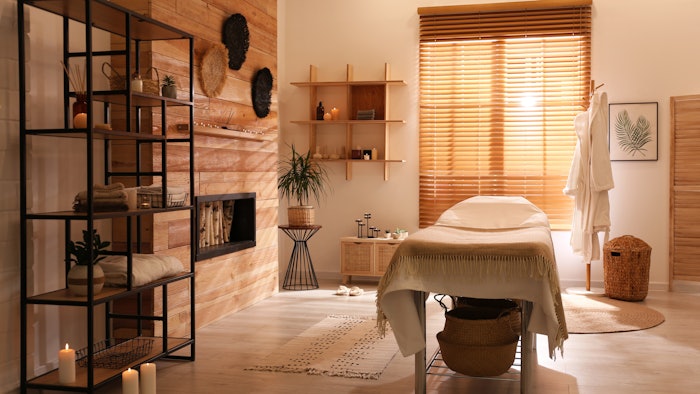
Why does your spa’s design matter? For the guest, design enhances relaxation, ease of navigation and supports a holistic wellness experience. For the employee, smart design makes it possible to provide services effectively and efficiently.
Log in to view the full article
Why does your spa’s design matter? For the guest, design enhances relaxation, ease of navigation and supports a holistic wellness experience. For the employee, smart design makes it possible to provide services effectively and efficiently.
Today, it is more important than ever to create a spa that is not only beautiful, noteworthy and profitable, but functional as well. Proper function helps to create exceptional customer service, makes guests feel relaxed, keeps staff satisfied and contributes to the bottom line through repeat business, word of mouth advertising and upselling capabilities.
Design Considerations
Is there a formula for determining how to design a spa with all the appropriate spaces? The number and type of treatment rooms? How much equipment and which brands? Do you need a gym? Beauty salon? What amenities contribute to the overall spa experience?
All these questions pertain not only to the spa itself, but also to the overall hospitality development and its financial well-being. They are key for designing a spa that functions optimally for the constraints, demographics and unique opportunities of a property.
Here is a list of “must ask” questions that must be answered for your design team to work effectively:
- How many guests will the spa be serving?
- How will spa use change during different periods of the year?
- How do we attract group business? Which groups will utilize the spa?
- How can we create a spa that encourages group business?
- Can the spa expect large numbers at one time and is there potential?
- Who is the guest and what are their demographics?
- If it’s part of a hotel, are there other areas where wellness opportunities may be provided (outdoors, F&B, in room, etc.) and is the placement of the spa correct for appropriate flow?
- Will there be a thermal area (sauna, steam room, whirlpools) requiring extensive mechanical space and cost? Do we need this?
- Is there an outdoor spa component? Will spa guests receiving treatments or relaxing without treatments have access to a pool? Sundeck?
- Can fitness be incorporated into the surrounding outdoor spaces?
- Should we have a private membership, and how will members use the spaces?
Related: 4 Green Spa Design Trends from Sustainability Experts
The answers to these and a myriad of other questions hold the key to a proper schematic spa design, which will make a remodel or new build a profitable venture for ownership. The extra time taken by the spa consultant, design team and ownership to review space placement, size and adjacencies will result in a thoughtfully designed spa and successful facility.
Spas and their multifaceted offerings can pose inherent design challenges. High energy areas such as locker rooms with showers, bustling beauty salons and upbeat fitness centers must coexist with tranquil treatment spaces and relaxation areas. When these areas are properly balanced and are the right size, they produce revenue and can coexist without chaos.
Devising the Perfect Space
At the end of the day, good design is about creating a space that functions comfortably and is comfortable—where staff can do their jobs without complications and guests can enjoy their experience without interruption. In an environment with exceptional operational flow, staff are more satisfied, turnover is reduced, overstaffing is unnecessary, and thus, payroll is lower. Guests who can feel comfortable and relaxed in the space will become loyal to the spa, will stay for longer and will spread the word about their positive experience.
What are the tangible steps for a spa renovation that fits your specific needs? First, develop a proper budget well in advance and communicate it to the consulting and design teams. This way, stakeholders understand the timing of their return on investment and operations can make any necessary design concessions (typically due to space and budget limitations).
Spas can cost $500-$1,000 per square foot, depending on whether the project is a renovation or new build, whether it will include a pool(s) and thermal features, the geographic location of the project, local construction costs, etc. A realistic budget is the first step toward a desirable financial outcome for any spa.
Then, in the second capital budget, there is the furniture, fixtures and equipment (FF&E) budget, which usually runs around $75 per square foot.
Ultimately, the space’s revenue per square foot should show that it is a profitable venture. Though back-of-house areas, locker rooms, etc., are not direct revenue-producing spaces, they must be included in the size calculations.
A guest’s spa experience must extend beyond a treatment: The entire spa environment is crucial for creating a holistically relaxing experience. This includes spaces that enhance the relaxation experience, such as sound rooms, pool areas and outdoor sundecks.
A spa consultant should conduct a detailed feasibility analysis to help hone in on attainable goals for a spa facility. Through this process, management may gain a better understanding of existing metrics, future target metrics, spa sizing requirements and staffing needs.
This process is crucial for identifying what should be changed about the space based on engineering expertise, guest complaints and repeated engineering malfunctions. The analysis will also take into account the potential daily and seasonal guest use potential. This will determine the optimal size of each individual spa space.
Ultimately, it is important not to try to be everything to everyone. A well programmed spa will be designed to achieve its specific goals for its specific place, environment and guest demographic. Taking extra consideration at the design stage will result in exponential benefits down the line for guests, staff and overall facility success.
Lynn Curry, principal at Curry Spa Consulting Inc., a consulting firm with worldwide recognition. Curry has consulted in many different capacities, from helping design some of the world’s most unique spaces to providing business services for profit improvement. She is based in Sonoma, California and can be reached at [email protected].









